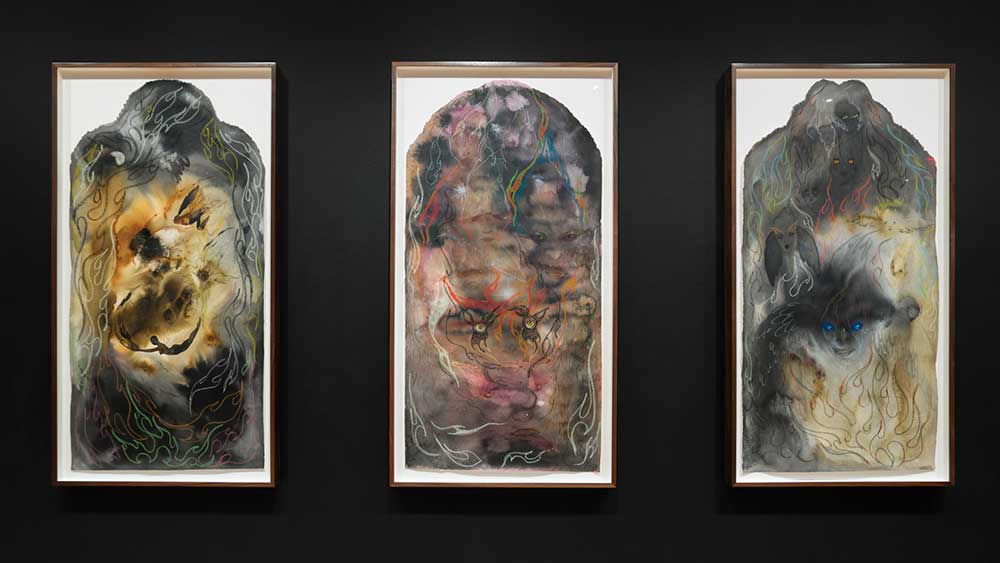
Naudline Pierre: This Is Not All There Is, Installation view, The Drawing Center, New York, 2023. Photo: Daniel Terna.
The Drawing Center, New York
2 June – 10 September 2023
by HATTY NESTOR
Naudline Pierre’s This Is Not All There Is invites us into a fictional, mythical world of creatures and iconography. The spiritual and medieval sensibility found throughout her richly hued paintings, layered wash drawings and sculptures is rooted in moments of transition, tranquillity and rest. The uncanny world we encounter at this exhibition is as unique as it is strange – it meanders between reclaiming traditions of painting Black women in Eurocentric art history and just-recognisable experiences of the holy and divine. Communality, world-building and religious iconography also underpin Pierre’s magical world, at the same time as she presents a completely new universe. This back-and-forth between the real and imagined is entirely of Pierre’s making and is the thread that weaves this eclectic tapestry in each instance.
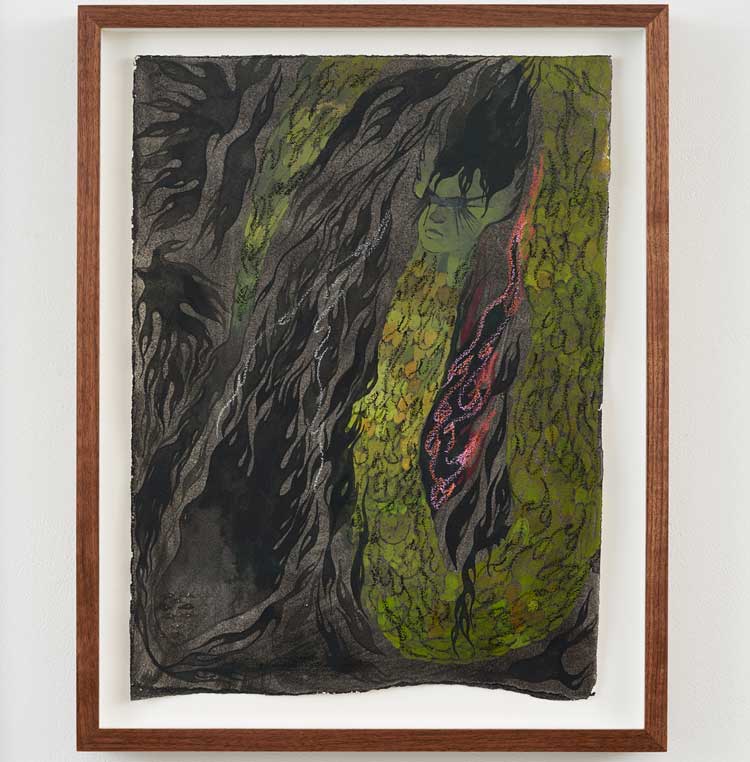
Naudline Pierre, Don't Be Afraid, 2022. Acrylic, ink, and chalk pastel on paper, 15 x 11 in (38.1 x 27.9 cm). Courtesy of the artist. © Naudline Pierre and James Cohan, New York. Photo: Matthew Herrmann.
Pierre is the daughter of a Haitian minister, so it is perhaps not surprising that spiritual and medieval sensibilities recur throughout her paintings. She studied at Andrews University, a small Christian liberal arts school in Michigan, before completing an MFA at New York Academy of Art. She had always been fascinated by the figurative and once her imagination was let loose, her work began articulating fantasies, where a liminal space between the real and imagined emerges, giving way to Pierre’s inner world. Across all her works, there is an enduring sense of her relationship to realms of regeneration, empowerment, rebirth and renewal. In contrast, cycles of death, mourning and transcendence generate a sense of endless longing and change, where nothing is quite what it seems.
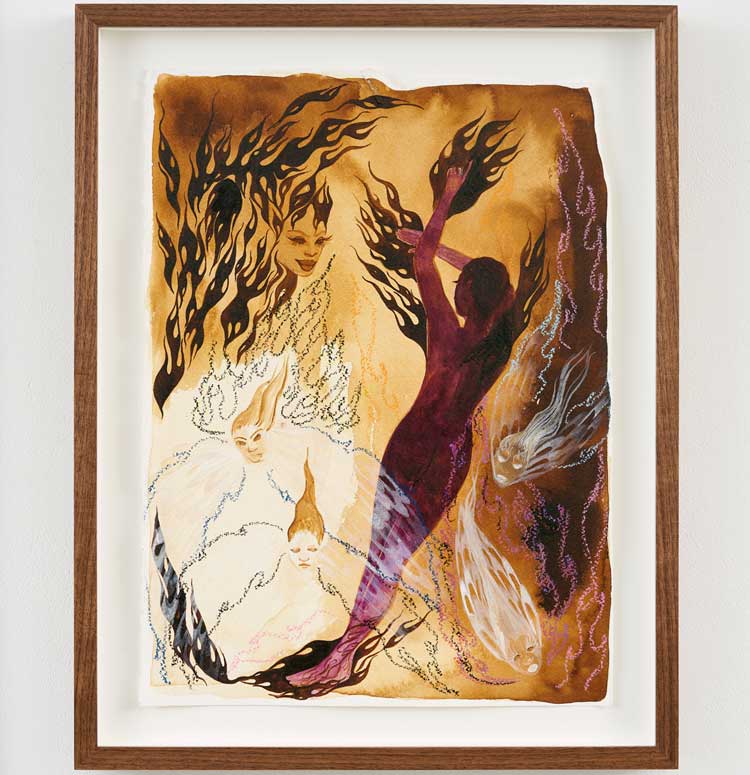
Naudline Pierre, Unto You I Release Myself, 2022. Acrylic, ink, and chalk pastel on paper, 15 x 11 in (38.1 x 27.9 cm). Courtesy of the artist. © Naudline Pierre and James Cohan, New York. Photo: Matthew Herrmann.
Pierre’s palette is often found in earthy tonalities – browns and forest greens, autumn reds and sunset yellows. Yet movements of turquoise, teal blue and electric red often puncture these fluid scenes, her pencil effortlessly guiding these spirals and swirls. Ink also bleeds into the corners of paint, pencil, chalk and pastel, defining where it condenses on the page. In Shadows (2023), three figures are all angled to the right, merging with the outline of flames; a similar energy is found in Whirlwind 2023, in which several creatures are caught in a spiralling formation. Similarly, Mist (2023) depicts three heads in a light, reddish-brown pastel, looking in different directions and moving against one another. Each seems to have its own agenda and greater sense of self – the largest face centred and calm, while those below it appear possessed. Yet in unison, each speaks to a wider commitment to tenderness through interaction, with an eerie sense that everything could change in a flash.
The exhibition, curated by Claire Gilman, is organised to accentuate this continuity, where each painting seems to be in conversation with the next. This is also apparent in the construction of the artworks, and how the paper appears to be a surface on which colours can merge and become a living organism. In Follow (2023), bat-like creatures dart across a teal-wash backdrop, almost following one another in a harmonious flight path. Down, Down (2023) has a similar composition and the title also reflects the movement of the piece – an uncanny figure diving downwards. Flames act as accents to its hands and feet, and a spirit-like orb floats above, as if caught in a chase. Inside (2023) reconfigures this sense of circulation and current, where the brown creatures become unified through their placement within floating flames.
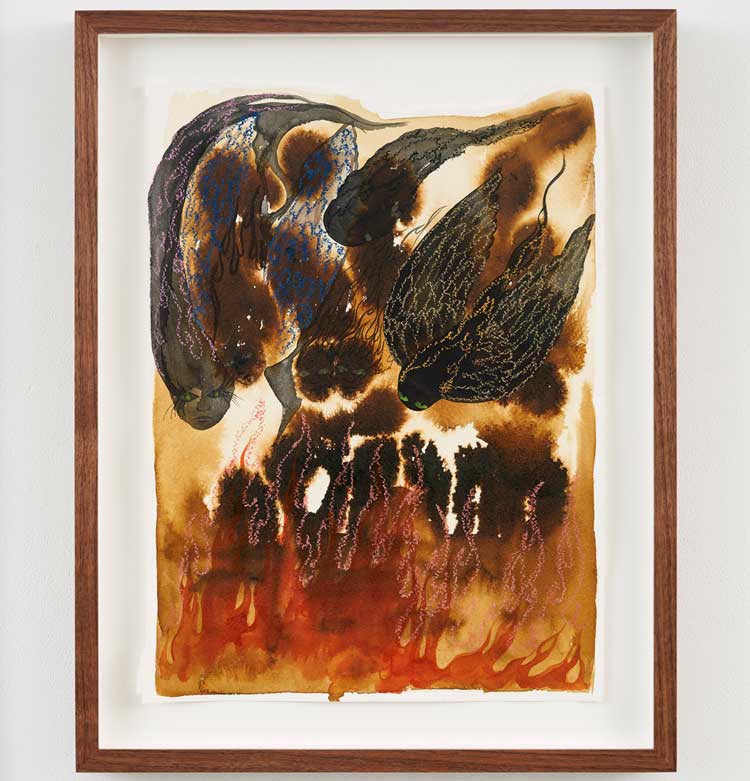
Naudline Pierre, Come What May, 2022. Acrylic, ink, and chalk pastel on paper, 15 x 11 in ((38.1 x 27.9 cm). Courtesy of the artist © Naudline Pierre and James Cohan, New York. Photo: Matthew Herrmann.
The textures of these paintings, the synergy between the figures found within them, and the attention to fantasy and the uncanny, places them in a harmonious world of communality and togetherness. Yet in all Pierre’s paintings, there is a sense that the ephemeral creatures that take centre stage could be angels or otherworldly beings, despite having human-like expressions and qualities. These are the slippages between the inner and outer world of Pierre’s mythology-making, where multiplicities of characters experience freedom, guilt, desire and shame. But within this fantastical world, experience transcends the everyday, opening on to themes of religion, sin and the supernatural. As viewers, we enter Pierre’s world and experience it as familiar and yet other – which is perhaps where the binaries of good and bad emerge.
Other artworks focus more on just one or two figures, and there is less sense of an overall scene – shifting the focus from narrative to identity. In Come What May (2022), winged creatures swoop down towards reddish-brown flames and characters, magnets to the heat of its surface. Some of their expressions are unrecognisable, but their greenish-blue eyes give definition to their faces. Brown splodges erupt across the paper; this unifying of the elemental and mythical is consistently found throughout the artist’s work, yet here it has connotations of an underworld, or purgatory. Into the Abyss (2022) could be perceived as another section of Come What May, as if the two were in one painting. A similar muddy orange provides the background to multitudes of winged heads, mythical creatures and beings. Existing alongside one another, some on downward trajectories, some appearing to soar upwards, one wonders whether they are moving towards an abyss.
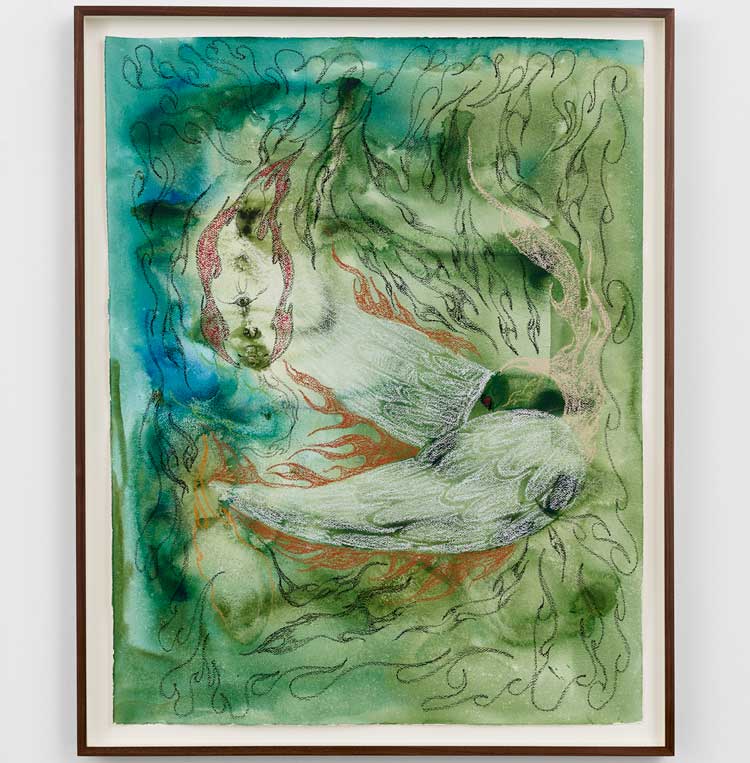
Naudline Pierre, Halted Understanding, 2023. Acrylic ink, charcoal, and oil pastel on paper, 40 x 30 in (101.6 x 76.2 cm). Courtesy of the artist. © Naudline Pierre and James Cohan, New York. Photo: Matthew Herrmann.
This fantasy seems to have parallels with the limitations and complexities of the otherworldly and image-making in the medieval iconographic tradition – making new, sublime worlds out of nothing. Temporally, there is always a sense of diffusion soaring in neither sky nor space – the sense of timelessness accentuated by the absence of cultural signifiers. However, the three similar sculptures The Time Is Near (Beginning), The Time Is Near (Middle) and The Time Is Near (End) (all 2023) repurpose this industrious, medieval sense of architecture into a three-dimensional form. Their titles give a sense of temporality being a linear triptych – yet each sculpture appears the same, and their patterned steel is uniform across all three. Like tall thrones you might find at the head of a table, they dominate, a severe presence in the room. Their flame-like backs are reminiscent of the shapes found in the paintings and there is a sense that all Pierre’s works are interconnected through this element of fire.
At the Drawing Center, I found myself returning to This, I Know to be True (2023), an acrylic, charcoal and oil pastel painting composed entirely of blacks, browns and hints of red and muted yellow, whose moodiness dominates the room. Something about the trio of characters where fantasy and intimacy is accentuated in this piece, for instance, t he fierce yellowish eyes of one figure coupled with the haunted appearance of the central one, and the lingering presence of the one at the back. There is a three-dimensional feeling to the expression of each of the characters, an intimation that salvation, harmony and sacrifice can all exist at once.
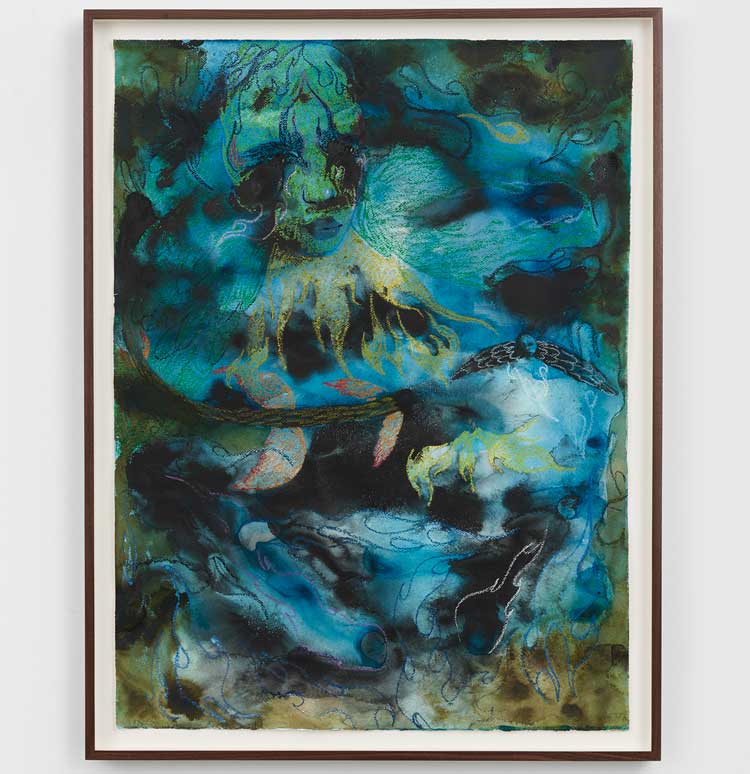
Naudline Pierre, Welcome the Unknown, 2023. Acrylic ink, charcoal, and oil pastel on paper, 40 x 30 in (101.6 x 76.2 cm). Courtesy of the artist. © Naudline Pierre and James Cohan, New York. Photo: Matthew Herrmann.
For me, though, the most electric work in the show, and also the most abstract, is Welcome the Unknown (2023). The teal blues of abstract faces and creatures merge in an unrestrained manner, making it hard to differentiate between object and form. On closer inspection, small differentiable objects come into view – faces and snakes make up some of its composition. In this act of looking closer, Pierre subtly reminds us that our initial perception of the world is not all there is – and that we all have the capacity to reimagine the world in which we live.